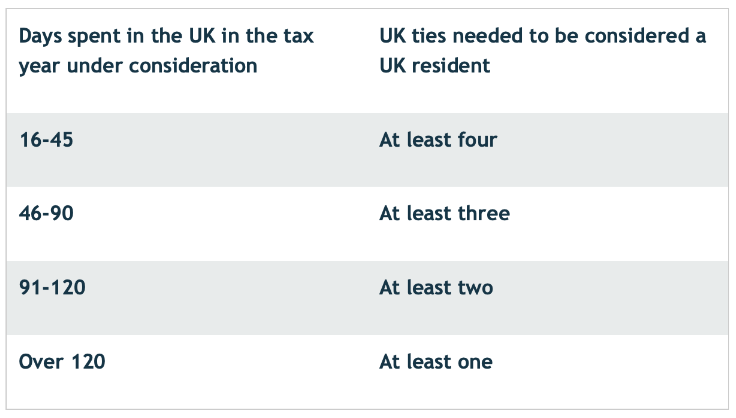The Statutory Residence Test is the method which decides on the UK tax residency status for those who have connections to the UK regardless of whether they reside in the UK or not. HMRC introduced the test on April 6, 2013.
The Statutory Residence Test, although complicated, is essential in knowing your UK tax residency status. Being defined as a tax residence within the UK could indicate that your income from anywhere can be taxed under UK taxation, and failing to declare and pay taxes on any income can result in penalties.
The Statutory Residence Test can be confusing, so it’s always recommended that you seek professional guidance from a tax professional with expertise in finding your residence status.
Four fundamental elements make up the Statutory Residence Test:
In the most basic terms, you’ll be classed as a non-UK resident for tax purposes if you satisfy the automatic overseas test and do not pass the automated UK test or the Sufficient Ties Test.
In the simplest sense, if you had more than 183 consecutive days spent in the UK during a particular tax year, you will typically be considered to be a UK resident. However, finding out the exact number of days you spend in the UK can be challenging. HMRC has set out a range of rules to determine what they class as a day. You may have spent the day in the UK when you arrive here at midnight on a particular day.
It is normal to be considered to be a non-UK resident for tax purposes when you satisfy any one of the following requirements that make up the Automatic Overseas Test:
To calculate the duration of working within or outside of the UK, it is advisable to consult with a professional, as numerous complicated calculations and factors will be considered.
When the Automatic Overseas Test is inconclusive, or you fail all of the tests, the following step would be to look at an Automatic Residence Test. If you meet one of these criteria, you will be considered a UK Resident. However, again, there are complicated calculations to be done which is why you must consult a professional before making any decision regarding the status of your residence.
Firstly, if you spend over 183 days in the UK in the tax year.
Secondly, if your main home is in the UK and you spend 91 consecutive days or more there, including 30 inside the tax year.
Finally, if you work in the UK for 365 days with no significant breaks, there are several calculations and requirements to fulfil, so please seek advice if you are concerned.
If, after reviewing your previous test results, you’re still determining your residence status, you should look at the test for sufficient ties.
The Sufficient Ties Test determines how many connections you have to the UK. These ties would be:
Knowing how many ties are required to establish your residency status is contingent on how long you were in the UK during the tax year.
The table below simplifies the process, but you should seek expert advice for a more accurate assessment.

The sufficient ties test is particularly useful for individuals who spend a significant amount of time in both the UK and another country, as it allows for more flexibility in determining residency status. However, it is important to note that the rules around residency can be complex, and individuals who are unsure of their status should seek professional advice.
One area where the statutory residency test has been particularly useful is in providing clarity around the tax treatment of non-domiciled individuals. Prior to the introduction of the test, non-domiciled individuals could effectively avoid UK tax on their overseas income by spending less than 183 days in the UK. However, under the new rules, non-domiciled individuals who have been resident in the UK for at least 15 out of the previous 20 tax years are deemed to be UK domiciled for tax purposes, meaning that they are subject to UK tax on their worldwide income.
Overall, the UK statutory residency test has been a useful tool in providing clarity and certainty around residency status for tax purposes. While the rules can be complex, they provide a clear framework for individuals to determine their status and ensure that they are complying with their tax obligations.